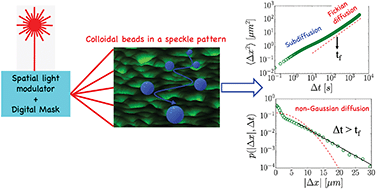A model-system of Fickian yet non-Gaussian diffusion: light patterns in place of complex matter
Abstract
Fickian yet non-Gaussian Diffusion (FnGD), widely observed for colloidal particles in a variety of complex and biological fluids, emerges as a most intriguing open issue in Soft Matter. To fully monitor FnGD and advance its understanding, recording many trajectories over a large time range is crucial, which makes experiments challenging. Here we exploit a recently introduced experimental model of finely tunable FnGD: a quasi-2d system of Brownian beads in water moving in a heterogeneous energy landscape generated by a static and spatially random optical force field (speckle pattern). By performing experiments at different optical power, we succeed in monitoring the evolution as well as the precursors of FnGD. Fickian scaling of the mean square displacement is always attained after a subdiffusive regime while the displacement distributions keep on being non-Gaussian, which allows for measuring a characteristic length- and time-scale for the onset of FnGD, ξf and tf. We find that ξf stays constant, whereas tf grows as the inverse of the long-time diffusion coefficient tf ∝ D−1 for increasing the optical power. Deviations from the standard Gaussian shape of the displacement distribution are neatly characterized on a broad range of times, focusing on the excess probability at small displacements and on the decay-length of the distinctive exponential tails. Such deviations are fully built in the subdiffusive regime and, at the FnGD onset, grow with the optical power. As time goes on, the small-displacement probability narrows and the exponential tails progressively break up, with a tendency to recover the Gaussian behaviour. Overall, both subdiffusion and FnGD become more marked and persistent on increasing the optical power, suggesting a strict relation between these two regimes. As clearly demonstrated by our results, the adopted model-system represents a privileged stage for in-depth study of FnGD and opens the way to unveil the nature of this phenomenon through finely tuned and well-controlled experiments.



 Please wait while we load your content...
Please wait while we load your content...